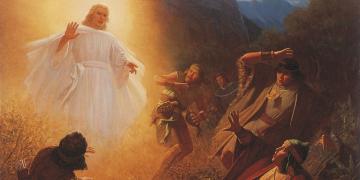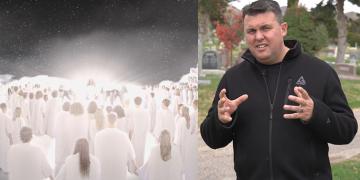You are here
Book of Mormon Central is in the process of migrating to our new Scripture Central website.
We ask for your patience during this transition. Over the coming weeks, all pages of bookofmormoncentral.org will be redirected to their corresponding page on scripturecentral.org, resulting in minimal disruption.
Alma the Younger’s Conversion is a powerful story in the Book of Mormon that teaches about the joy of redemption, the power of prayer, and the miracle of conversion. There are three different accounts of this experience, each with their own perspectives on the event; Mosiah 27, Alma 36, and Alma 38. Book of Mormon Central has written quite a bit on this remarkable experience, but here are what we think are some of the best insights on this incredible story.
This Incredible Chiasm Helps Us Pinpoint the Crux of Alma’s Conversion
No other event had a greater impact on Alma’s life than the transformative three days he spent racked with torment after being rebuked by an angel. Alma 36 stands out as the most complete and well-composed account of this event. Its chiastic composition eloquently and effectively guides the reader most centrally and emphatically toward Alma’s direct, personal encounter with Jesus Christ. Ultimately, Alma’s conversion occurred when he remembered his father speaking of “the coming of one Jesus Christ, a Son of God, to atone for the sins of the world.” It is hard to imagine any literary form being used more effectively than this extended chiasm to articulate the transformative effect of the Christ’s Atonement.
Book of Mormon Central. “Why Was Alma Converted? (Alma 36:21).” KnoWhy 144 (July 15, 2016).
Alma’s Conversion Didn’t Happen Because of the Angel
It can be easy to think that Alma the Younger was converted by an angel, and thus wish that we could personally have such miraculous experiences in order to become truly converted. However, a careful analysis of Alma’s story reveals that true conversion does not come from dramatic experiences external to ourselves, like seeing an angel; rather, rather it comes through the inward, personal struggle to repent and turn our hearts to Christ, allowing his atonement to cleanse of our sins and turn us into “new creatures.” Alma’s rebirth and conversion is literarily illustrated in Mosiah 27 by setting out 8 contrasting parallels between his behavior before conversion and his changed behavior after he is “born of God.” This contrast illustrates that Alma changed completely and totally, in every way, from who he was before his conversion, demonstrating that true and lasting conversion has a comprehensive impact on how we live our lives.
Book of Mormon Central. “How Can Contrasts Teach Us about True Conversion? (Mosiah 27:25).” KnoWhy 562 (May 19, 2020).
The Angel that Appeared to Alma Communicated in Ways that Would Have Made Sense in Alma’s Time Period and Location
When the rebellious Alma the Younger was confronted by a messenger from God, the angel “descended as it were in a cloud; and he spake as it were with a voice of thunder.” That the angel manifested himself in this way makes sense in many contexts, especially from ancient Near Eastern and Mesoamerican perspectives. From an ancient Near Eastern perspective, the voice of the angel signifies the terrifying power of the storm god or divine warrior. From a Mesoamerican perspective, it associates the angel with the dying-resurrecting maize god, whom the Nephites worshipped in the form of Jesus Christ. This shows that the Lord reveals himself to his children according to their culture and understanding.
Book of Mormon Central. “Why Did the Angel Speak to Alma With a Voice of Thunder? (Mosiah 27:11).” KnoWhy 105 (May 23, 2016).
Multiple Accounts of Alma’s Experience Can Strengthen Our Faith in Joseph Smith’s First Vision
Like Joseph Smith's first vision, Alma the Younger’s experience with the angel is recorded multiple times. Alma’s three tellings of his conversion story shed light on Joseph Smith’s multiple tellings of his First Vision. Distinctive phrases shared between the accounts show that they came from the same person. In the cases of both Alma and Joseph Smith, differences between accounts make sense because they were writing about the experience to different audiences at different points in their lives. Just as Alma and Joseph Smith drew strength from their spiritual experiences throughout their lives, as the modern reader can today.
Book of Mormon Central. “Why Are there Multiple Accounts of Joseph Smith's and Alma's Visions? (Alma 36:6–7).” KnoWhy 264 (January 20, 2017).
Being Born Again is an Integral Part of True Conversion
The need for Christ’s followers to be “born again,” as famously described in John 3:3, is one of the most well-known New Testament doctrines. It captures mankind’s universal need for spiritual transformation and offers hope that such transformation can come to all who seek it. Yet this doctrine has also become a matter of debate and controversy among some Christian believers. Thankfully, the Book of Mormon discusses being born again on a number of occasions. Its relevant passages can clarify and deepen our understanding of this vital Christian doctrine.
Book of Mormon Central. “What Does It Mean to Be “Born Again?” (Mosiah 27:25).” KnoWhy 501 (February 7, 2019).
Conclusion
In your study of Alma the Younger this week, consider all the ways that you can personally deepen your conversion to Jesus Christ. Alma the Younger’s story gives hope to parents with wayward children. But most importantly, it gives hope to all of God’s children. No matter how far we stray from the path, we are never too far from the reach of the grace and mercy of Jesus Christ.
Subscribe
Get the latest updates on Book of Mormon topics and research for free










